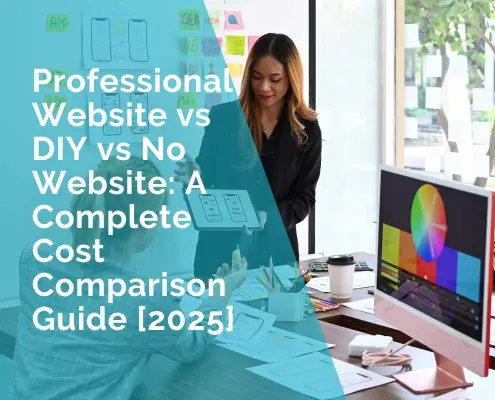The Impact of Google’s Core Web Vitals on SEO
If you’re striving to improve your website’s performance, understanding and optimizing Core Web Vitals is essential. These metrics, introduced and monitored by Google, are crucial indicators of your website’s overall user experience, which in turn, can significantly impact your website’s search engine rankings. As the digital landscape becomes increasingly competitive, providing a seamless and efficient user experience is more important than ever.
Core Web Vitals offer a standardized way to measure and enhance critical aspects of this experience, such as loading times, interactivity, and visual stability.
By focusing on these metrics, you not only improve your site’s performance but also increase its appeal to users and search engines alike. Let’s explore this a little deeper and make sure you’re ticking the right things off according to Google’s requirements.
We’ll delve into what Core Web Vitals are, why they matter, and how you can effectively optimize your site to meet and exceed these vital performance benchmarks. Understanding these elements will empower you to create a website that is not only high-performing and user-friendly but also better positioned to rank well in search results.
What are Google’s Core Web Vitals?
The Core Web Vitals are a set of three specific metrics that Google considers important in a webpage’s overall user experience. Each of these metrics focuses on a different aspect of the user experience: loading, interactivity, and visual stability.
Largest Contentful Paint (LCP)
This measures the time it takes for the main content of a page to load. Ideally, this should occur within 2.5 seconds of when the page starts loading. LCP is a direct indicator of how quickly a visitor can see and interact with your content, which can be critical for retaining visitors and reducing bounce rates.
First Input Delay (FID)
FID measures the time from when a user first interacts with your site (i.e., when they click a link, tap on a button, or use a custom, JavaScript-powered control) to the time when the browser is actually able to begin processing event handlers in response to that interaction. A good threshold to aim for is less than 100 milliseconds. This metric is crucial for understanding how users perceive the responsiveness of your site.
Cumulative Layout Shift (CLS)
CLS measures the sum total of all individual layout shift scores for every unexpected layout shift that occurs during the entire lifespan of the page. A layout shift occurs whenever a visible element changes its position from one rendered frame to the next. Keeping this score below 0.1 ensures that your page feels stable as users scroll through content, helping prevent frustrations like clicking on the wrong button because it moved.
Each of these metrics provides a snapshot of different elements of user experience that, when optimized, can lead to a smoother, more engaging site that visitors are more likely to return to.
Why Core Web Vitals Matter for SEO
Google’s introduction of Core Web Vitals as a ranking factor underscores its commitment to enhancing the user experience. Websites that load quickly, respond promptly to user inputs, and maintain visual stability tend to rank higher because they offer a better user experience. This approach by Google reflects a broader shift in SEO from focusing solely on keywords and backlinks to prioritizing how users experience web pages. When your site performs well in these areas, it not only helps to retain visitors but also potentially increases your organic search rankings, leading to more traffic and conversions.
Moreover, as mobile usage continues to dominate internet access, the performance of websites on smartphones and tablets has become crucial. Core Web Vitals are part of Google’s criteria for good mobile performance, aligning with their mobile-first indexing strategy. This means that Google predominantly uses the mobile version of the content for indexing and ranking, making it more important than ever to optimize these vital metrics.
How to Measure Core Web Vitals
Fortunately, Google provides several tools to help website owners measure and analyze their Core Web Vitals. The most accessible of these is Google’s PageSpeed Insights. This tool not only measures the Core Web Vitals but also provides a comprehensive report on what aspects of the page need improvement. It breaks down the elements that contribute to each Core Vital and offers specific suggestions on how to optimize them.
Another vital tool is Google Search Console’s Core Web Vitals report. This report groups pages by status (good, needs improvement, or poor) and identifies the specific Core Web Vital causing issues, which helps webmasters prioritize fixes based on the impact on user experience.
For those looking to dig deeper, Chrome User Experience Report provides real-world user experience insights on how actual users experience pages across the internet. This can be particularly useful for comparing your site’s performance against industry benchmarks.
By utilizing these tools, webmasters can obtain a clear picture of where their site stands concerning Core Web Vitals. The next step involves taking targeted actions to address any issues, thus enhancing both user experience and SEO performance. These improvements often involve collaborative efforts between developers, designers, and content creators to ensure that a site not only looks appealing but also works efficiently and effectively for every visitor.
Strategies to Improve Core Web Vitals
Improving your website’s Core Web Vitals involves a combination of technical adjustments and strategic updates. Here are specific strategies for each metric:
– Optimizing Largest Contentful Paint (LCP): To improve LCP, focus on reducing server response times by optimizing your server, using a Content Delivery Network (CDN), and caching assets. Additionally, remove any unnecessary third-party scripts that may slow down loading, and defer the loading of non-critical images and videos until after the page has loaded. Compressing images and text can also drastically reduce load times.
– Reducing First Input Delay (FID): To minimize FID, limit the impact of third-party code and reduce JavaScript execution time. Break up long tasks into smaller, asynchronous tasks to avoid blocking the main thread, use a web worker, and remove any non-critical scripts that interfere with loading. Optimize the way your page parses and executes JavaScript by removing unused JavaScript and minimizing unused polyfills.
– Minimizing Cumulative Layout Shift (CLS): For a better CLS score, size all images, embeds, and ads with CSS aspect ratio boxes to prevent layout shifts. Make sure ad elements have a reserved space, and avoid inserting new content above existing content, especially if that content pushes down what’s visible to the user. Use CSS property `transform` for animations instead of properties that trigger layout changes.
Implementing these strategies requires a detailed examination of your site’s architecture and may involve significant changes to how your site is built and maintained. However, the payoff in improved user experience and potential gains in SEO makes this effort worthwhile.
Criticism
While for the most part, the impact of SEO is accepted, there are some critics and alternative perspectives on the importance of Google’s Core Web Vitals:
- Broad SEO Strategy: Some SEO experts argue that while Core Web Vitals are important, they are just one part of a broader SEO strategy. Content relevance, keyword optimization, backlinks, and other traditional SEO factors still play a crucial role in rankings. Focusing solely on Core Web Vitals might not yield significant results if other aspects of SEO are neglected.
- Impact Variability: Critics point out that the impact of Core Web Vitals on rankings can vary depending on the competitive landscape of specific industries and niches. In some cases, sites with excellent Core Web Vitals may not see a substantial ranking boost if their content and overall SEO strategy are not competitive.
- User Experience Focus: While Core Web Vitals are designed to improve user experience, some argue that user experience is subjective and can vary significantly based on the target audience. For example, a site with slower load times but highly engaging content might still retain and satisfy its users effectively.
- Algorithm Complexity: Google’s ranking algorithms are complex and incorporate hundreds of factors. Core Web Vitals are just a few among many. Some experts believe that their weight in the overall ranking algorithm might be less significant compared to other factors like content quality and backlinks.
- Implementation Challenges: Improving Core Web Vitals can be technically challenging and resource-intensive, especially for large, complex websites. Critics argue that smaller businesses or those with limited technical resources might struggle to make significant improvements, potentially disadvantaging them compared to larger competitors.
Conclusion
Optimizing Core Web Vitals is no longer just a technical SEO task—it’s a fundamental aspect of providing a pleasant user experience and enhancing your site’s performance in organic search results. As user expectations for fast, responsive, and stable web experiences continue to rise, prioritizing these metrics becomes crucial. Websites that commit to continuous monitoring and improvement of their Core Web Vitals not only see improved rankings but also enjoy higher engagement and conversion rates.
By integrating the strategies outlined in this article, you can start making data-driven improvements that directly benefit your visitors. Remember, the journey to optimize Core Web Vitals is ongoing. Regularly using tools like Google’s PageSpeed Insights and Search Console will help you track your progress and pinpoint new areas for improvement as web technologies and user behaviours evolve.
***
Author: LP












